Randori (乱取り) is a term used in Japanese martial arts to describe free-style practice (sparring). The term denotes an exercise in 取り tori, applying technique to a random succession of uke attacks.
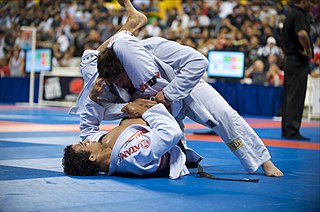
Brazilian jiu-jitsu is a self-defence martial art and combat sport based on grappling, ground fighting, and submission holds. BJJ focuses on taking ones opponent down to the ground, gaining a dominant position, and using a number of techniques to force them into submission via joint locks or chokeholds.
The following outline is provided as an overview of and topical guide to martial arts:
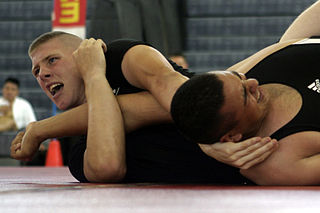
Submission wrestling, also known as submission grappling, submission fighting or simply grappling, is a competitive martial art and combat sport that focuses on ground fighting and submission techniques. It is a hybrid discipline that incorporates elements of various grappling arts such as various wrestling styles, judo, and Brazilian jiu-jitsu. Submission wrestling is practiced both as a competitive sport and as a training method for self-defence and mixed martial arts (MMA).
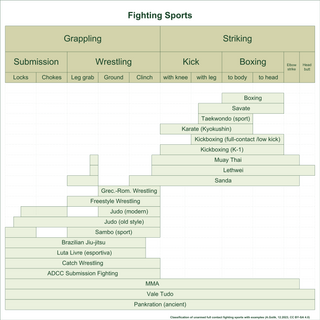
A combat sport, or fighting sport, is a contact sport that usually involves one-on-one combat. In many combat sports, a contestant wins by scoring more points than the opponent, submitting the opponent with a hold, disabling the opponent, or attacking the opponent in a specific or designated technique. Combat sports share a long history with the martial arts.

Yoseikan budō (養正館武道) may be classified as a sōgō budō form, but is used here to indicate a martial art into which various martial ways have been integrated. It is probably most widely known for its descent from a pre-war style of aikido; however, it has important connections to judo, karate, western boxing, savate, and a traditional forms of Japanese combat known as gyokushin-ryū jujutsu and Tenshin Shōden Katori Shintō-ryū.
A joint lock is a grappling technique involving manipulation of an opponent's joints in such a way that the joints reach their maximal degree of motion and hyperextension.
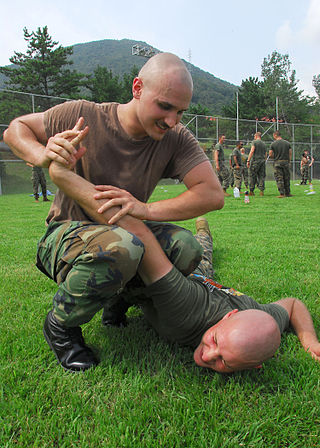
A wristlock is a joint lock primarily affecting the wrist-joint and, in some cases, the radioulnar joints through rotation of the hand. A wristlock is typically applied by grabbing the opponent's hand, and bending and/or twisting it. Wristlocks are very common in martial arts such as chin-na, aikido, hapkido and jujutsu where they are featured as self-defense techniques. They are also used as submission holds in martial arts such as Brazilian jiu-jitsu and catch wrestling. While being an illegal technique in modern sambo and judo competitions, it is still practiced in judo forms of self-defense kata kōdōkan goshinjutsu. Wristlocks are also widely used as pain compliance holds, often in police, military, and residential treatment centers.
Hybrid martial arts, also known as hybrid fighting systems or sometimes eclectic martial arts or freestyle martial arts, referred to as mixed martial arts or fighting systems that incorporate techniques and theories from several martial arts. While numerous martial arts borrow or adapt from other arts and to some extent could be considered hybrids, a hybrid martial art emphasizes its disparate origins.
Eskrido, a version of Doce Pares, is a Filipino martial art that is a combination of Doce Pares, Aikido, Ju-Jitsu and Judo, with lesser influences from other Japanese systems. It features standard eskrima stick techniques mixed with Jujutsu-style locks and throws that utilize the stick. The stickwork shows a strong sword influence, and indeed the sword, knife, and other Filipino weapons are also taught. It was founded by Ciriaco "Cacoy" Cañete, who taught it in the Philippines and in seminars across the world. The martial art was established in 1951. Cañete was the highest ranking practitioner in both Doce Pares Eskrima and Eskrido.
The Jitsu Foundation or TJF is a national-level association of sports clubs headquartered in the United Kingdom, but also has affiliated organisations in other countries around the world. Focusing on standing throws and locks using weakening strikes to assist, the style taught within the association is known as Shorinji Kan Jiu Jitsu(少林寺完柔術).
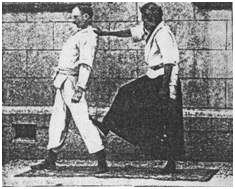
Kyūshin-ryū is a form of the martial art Jujutsu consisting of striking, throwing and grappling techniques. It was developed by the Samurai in feudal Japan as a method of dispatching an armored opponent using unarmed techniques. According to the Densho of various schools and historical records, these systems of unarmed combat began to be known as Jujutsu during the Muromachi period (1333–1568).

Jujutsu, also known as jiu-jitsu and ju-jitsu, is a family of Japanese martial arts and a system of close combat that can be used in a defensive or offensive manner to kill or subdue one or more weaponless or armed and armored opponents. It was designed in the 1530s and is coined by Hisamori Tenenuchi when he officially established the first school of Jiu-Jitsu in Japan. A subset of techniques from certain styles of jujutsu were used to develop many modern martial arts and combat sports, such as judo, aikido, sambo, ARB, Brazilian jiu-jitsu, and mixed martial arts.

The Ju-Jitsu International Federation (JJIF) is an international sport federation founded in 1998 after the expansion of the European Ju-Jitsu Federation (EJJF) for the propagation of the modern competitive sports version of Jujitsu, also known as Sport Ju-Jitsu.
Taiho-jutsu (逮捕術) is a term for martial arts developed by Japan's feudal police to arrest dangerous criminals, who were usually armed and frequently desperate. While many taiho-jutsu methods originated from the classical Japanese schools of kenjutsu (swordsmanship) and jūjutsu, the goal of the feudal police officers was to capture lawbreakers alive and without injury. Thus, they often used specialized implements and unarmed techniques intended to pacify or disable suspects rather than employing more lethal means.
Taijutsu is a Japanese martial art blanket term for any combat skill, technique or system of martial art using body movements that are described as an empty-hand combat skill or system. Taijutsu is a synonym for Jujutsu. The words jujutsu, taijutsu, and yawara can be used interchangeably. The term is commonly used when referring to a traditional Japanese martial art but has also been used in the naming of modern martial arts such as Gendai Goshin Jutsu, Yamabujin Goshin-Jutsu, Fuji Ryu Goshindo JiuJitsu and Bujinkan Budo Taijutsu. Taijutsu is similar to Karate but is more focused on the body techniques. More specific names than taijutsu are typically used when describing a martial art: Judo, Aikido as well as Karate and Kenpō.

Tsegaye Degineh Gugssa is an Ethiopian economist. He is holder of the Federal Cross of Merit, Knowledge Transfer Activist and the first Ethiopian mainly brought modern Ju-Jitsu to Ethiopia. He received his Ph.D. (2000) at the Department of Economics and Business Administration, Humboldt University Berlin and holds 6th Dan in Ju-Jitsu that initially dominated by the style of the German Ju-Jitsu Federation.
Atemi Ju-Jitsu, in Japanese: Atemi (当て身) Jujutsu (柔術), also called Pariset Ju-Jitsu, was established in France in the 1940s by the late Judo and Ju-Jitsu legend Bernard Pariset to revive and preserve old martial techniques inherited from Feudal Japan.
Hokutoryu Ju-Jutsu is a Finnish style of the Japanese martial art jujutsu developed in 1977 by Auvo Niiniketo. The name of the style is Japanese and literally translates as Big Dipper-style, though is more commonly translated as North Star-style. The style uses a Japanese name to show respect to the country of origin of jujutsu. Practitioners of the style can be recognized by the logo of the style on their jujutsugi, a red inversed triangle.








